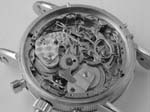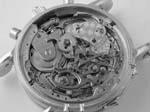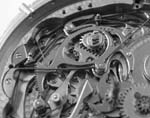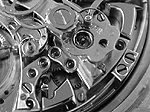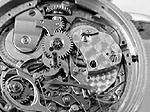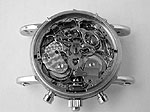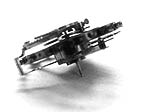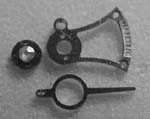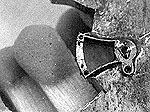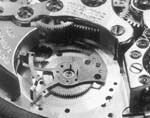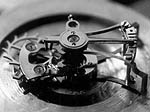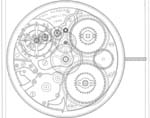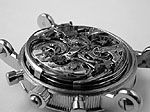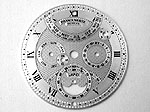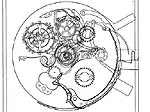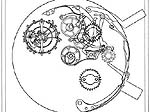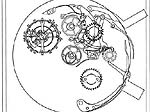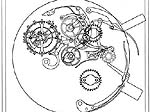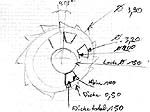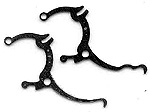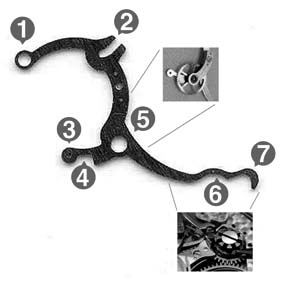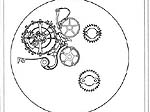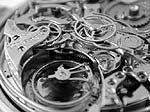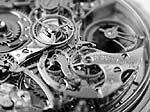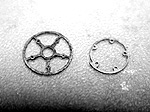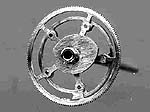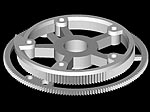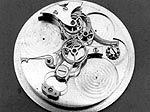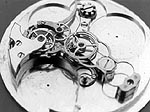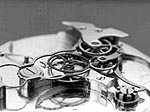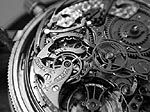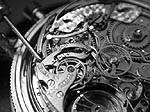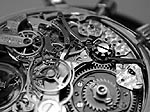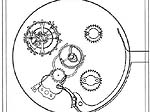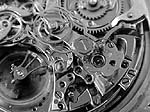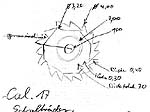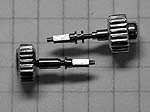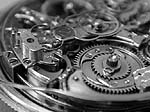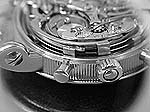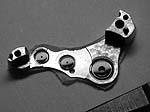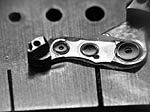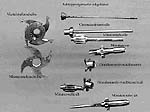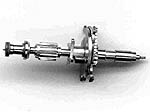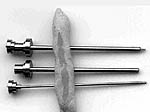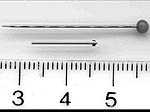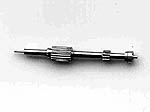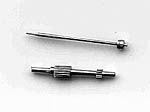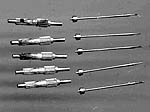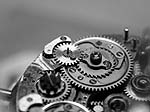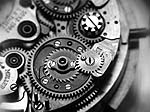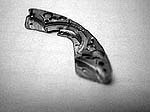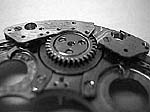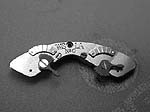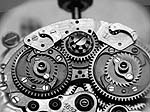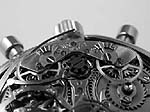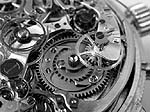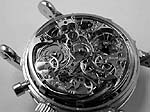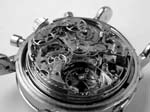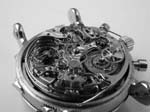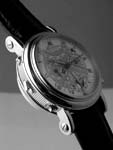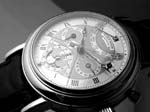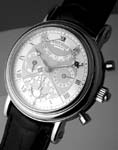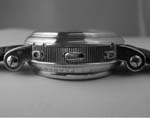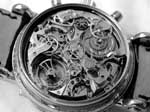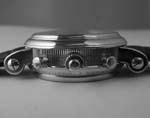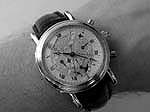4. Detailed descriptions of the added complications:
The Sonnerie and Repeater:
One of the
most challenging and certainly the most complex classical Grande Complication,
the Grande et Petite Sonnerie and Minute Repeater is an extremely exotic
animal. Even today there are only a handful of examples of this grandest
of complications and their numbers diminish exponentially as their size
decreases. For Philippe Dufour to make a Grande et Petite Sonnerie and
Minute Repeater in a wristwatch size in the late 20th century is a major
accomplishment, for Louis-Elysée Piguet to do so in a similar size
100 years earlier is nothing short of mind-boggling.
A Sonnerie is a watch that strikes the time in passing, much like a grandfather
clock. In "grande strike" position it will strike the number
of hours on a single gong at the turn of the hour and, in addition, at
the passing of each quarter hour will strike the hours with single chimes
and the quarters with double-chimes. In "petite strike" position
the hours will be struck on the hour and the quarters only as they pass.
For occasions when such music coming from your wrist might not be appropriate,
of course it is equipped with a "silent" position as well.
The Perpetual Calendar has become a "standard" in the world of complicated watches, but perpetually has its charm as a mechanism that knows a little bit about the future: It "knows" how the date indications will be set in, say, 97 years (needing the adjustment of a single corrector in the year 2100)!
Together with a thermometer, the Perpetual Calendar was added by Franck Muller, at the very beginning of his impressive and successful career. As far as can be judged from pictures, the Perpetual Calendar plate is of excellent execution and of classic design and layout as would seem most appropriate to add to such a traditional movement. The notable exception is the retrograde month indication, forecasting the multitude of retrograde indicators that Franck Muller has become known for in recent years.
Here are three pictures of the module (with the easily detectable retrograde mechanism at the 12 o'clock position), the Thermometer and of both, the module and the Thermometer, fitted on the dial side, above the minute repeater works. Please note that the retrograde indication mechanism is quite different from a retrograde second as we know them from Paul Gerber or Blancpain, for example:
That this construction is also more sophisticated, more difficult to assemble and a more visually appealing construction is merely welcome side-effects.
The construction of a new Chronograph mechanism is quite a technical feat that very few manufactures undertake. The broad use of the handful of commonly available Chronograph calibers is ample evidence of this. A Split-Seconds Chronograph is particularly challenging, many times more difficult than a simple Chronograph even, due to the incredible tolerances that must be realized to keep from putting a critical strain on the movement when the Chronograph is engaged and especially when the Split-Seconds mechanism is activated. The fine adjustment necessary and infinitesimal loads that must be balanced against each other make a Rattrapante possibly the most challenging complication to properly set-up and adjust.
In this special case, the mountain of difficulties was two or three times higher than usual: An incredibly complicated movement, a unique piece, should be upgraded with a Split-Seconds Fly back Chronograph, operated by a column wheel of course. Challenging even more so because the gongs of the Sonnerie and Repeater are in the way of the Chronograph pushers:
Since the movement was not intended to be fitted with a time-counting mechanism, there was of course no space reserved for it. Forced to use every bit of space that could hold a wheel or a lever, Paul Gerber invented one of the most classic looking and technically demanding Chronograph mechanisms ever seen:
Several characteristics of this exemplary Chronograph should be covered more in detail:
The control mechanism:
It is not surprising that Mr. Gerber chose to utilize a column wheel for the Chronograph controls. The column wheel has a lower portion with sixteen ratchet teeth and an upper portion with half as many columns. The ratchet teeth are advanced one tooth at a time by an operating lever and held in place by a jumper. As the column wheel rotates, the ends of the levers for the coupling lever and the brake alternately fall on a space or are lifted by the columns.
One of the remarkable things about this implementation is the exotic shape required of the coupling lever for it to facilitate multiple functions, the end of the coupling lever became increasingly thin and curvy until its final form was realized (shown here in two different evolutionary stages, new version is on top). In the following I want to describe the fancy details in note form:
- (1) To fix the coupling lever on movement
- (2) This slot serves two purposes during the resetting procedure: two pins are operated here: first, it moves the coupling lever out of the power train during resetting (via reset lever), second, it also moves the click of the Chronograph minute wheel (this click ensures proper positioning of the minute wheel)
- (3) In this hole the operating lever for the jumping minute counter is mounted and coupled in and out of the power train
- (4) This small indentation helps to control the depth of the allowed movement of the coupling lever. It is adjusted by an eccentric screw mounted on the movement plate
- (5) Here the jewel for the intermediate wheel is fixed (see small image)
- (6) Bow, necessary to guide coupling lever around blocking lever (see small image)
- (7) Pin that interacts with the column wheel through which the lever is operated (see small image)
As mentioned before, the existing case should be kept. This means that the additional Chronograph should not over egg the pudding too much. One measure to minimize the need for space and fitting points was the use of a jumping minute counter, which by the way counts a full hour (60min) instead of being limited to 30 or 45 min.
Since such a construction utilizes levers to transport the motion of the center seconds counter to the minute counter, Mr. Gerber was more flexible with the placement of the axes. Additionally, less energy is needed.
Everybody can imagine that a Chronograph only is really useful if it can be reset to zero. This was not possible with the first pocket watch Chronographs. Finally, when the watchmaker Adolphe Nicolet invented the heart cam in 1884, a Chronograph could be reset to zero after timing an interval without waiting for the Chronograph counters to arrive back on zero.
This is achieved with the use of a reset lever with flat, hammer surfaces pressing against the heart discs that are fixed on the Chronograph counters' arbors (each arbor of the Chronograph - seconds, minutes and hours - needs a heart cam to reset to zero). The reset hammers press against the edge of the heart cams (in whatever orientation they have stopped), causing them to rotate until the hammer is resting against the flat portion of the cam and the counters are reset.
A simple principle – but there is again our old challenge: no space. As you probably guessed by now, Paul Gerber found a way. The heart cams of the Chronograph seconds and minutes counters are not visible in our images (you only can see the heart cam of the split-seconds wheel), but in the next three pictures you can see the horizontally acting reset lever operating a hidden heart cam: (left) Chronograph stopped, (middle) reset lever activated (by screwdriver), (right) reset lever viewed from column wheel:
Never satisfied with "good enough", Lord Arran wanted to have a Rattrapante or Split-seconds Chronograph mechanism installed. Mr. Gerber embraced the challenge as an impassioned watchmaker and as a perfectionist. The result, like the other complications, is a beauty in its own right. As a matter of course, this mechanism also looks like it belonged there from the beginning.
How could Paul Gerber get all these magical works into the movement?
The implementation of the Chronograph mechanism caused some changes to the existing movement. Two changes should be highlighted here. One is a problem of thickness. The additional arbors for the Chronograph wheel and split-seconds wheel of course had to find their way through the central axis of the movement and the jumping minute counter arbor likewise had to find its way through the seconds wheel pinion. Because of this, new, larger pinions were necessary and consequently, new jewels with larger holes.
Mr. Gerber found himself confronted with replacing excellently executed vintage jewels with modern ones, so shaping and polishing a jewel nearly from scratch was the best solution. Here you can see the movement side of the center bridge with old (left image) and new (right image) seconds jewel in place (the far left jewel on the center bridge). Note also the fine finishing on the underside of the bridge.
The next step was the construction of a new center wheel pinion that could allow the passage of the two new Chronograph arbors (for the Chronograph and split-seconds wheels). This turned out to be one of the most challenging parts to manufacture since incredibly small tolerances had to be handled with utmost precision.
In a "simple" watch, this central axis already bears center wheel, center wheel pinion, the cannon pinion (and minute hand), the hour wheel (and hour hand) and sometimes the seconds pinion (and second hand). In the case of a striking watch, the center axis also has to carry the respective control discs for the striking mechanism. In the end, the final center wheel pinion is a piece of art on its own right. It consists altogether of eight parts: the split-seconds arbor, the Chronograph wheel arbor, the center wheel pinion and the cannon pinion which carries the quarter snail, minute snail and surprise piece, and the four lobed trigger star for the Sonnerie. In the lower part of this picture you can see some of the arbors and pinions that had to be manufactured from scratch.
Lord Arran also wanted to have an indication for the power reserve of both the timekeeping train and the striking mechanism. Paul Gerber fulfilled this desire by placing these indications around the column wheel of the Chronograph.
The Power Reserve is a little complex in that it gets information from the barrel and the ratchet wheel with two differential gears (for each barrel). This made it necessary to add a pinion to each barrel to drive the differential gears (which are fixed with the original screws!).
The
Introduction
The History
The Challenges
The complicated Complications
The Interview with Paul Gerber
